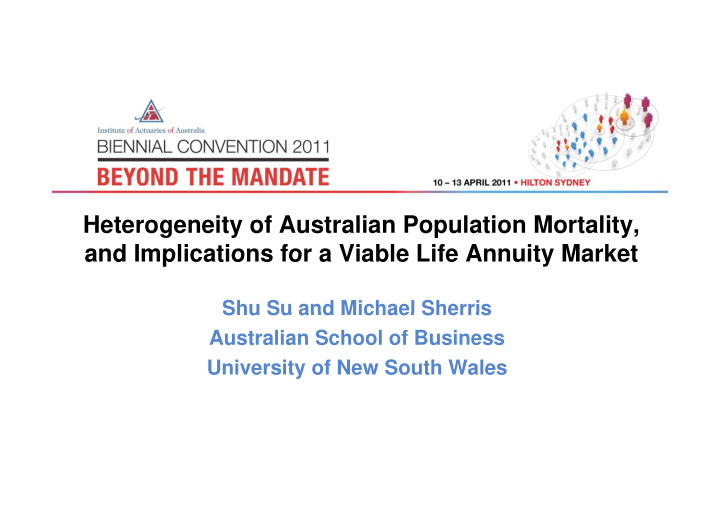



Heterogeneity of Australian Population Mortality, and Implications for a Viable Life Annuity Market and Implications for a Viable Life Annuity Market Shu Su and Michael Sherris Shu Su and Michael Sherris Australian School of Business University of New South Wales University of New South Wales
Agenda • Introduction I t d ti • Model Specification • Frailty Model Frailty Model • Markov Aging Model • Data • Results • Model Fitting • Impact on Annuity Rates I t A it R t • Conclusion
Background • Risks in an insured portfolio are heterogeneous Ri k i i d tf li h t • Ignoring heterogeneity: adverse selection • Risk rating using risk factors Risk rating using risk factors • Life Annuity • Limited use of rating factors • Demand for annuity products • Understanding heterogeneity • Pricing and adverse selection in annuity business • Pricing and adverse selection in annuity business • Underestimation of mortality improvement at higher ages
Research Objective • Quantifying mortality heterogeneity of Australian population Q tif i t lit h t it f A t li l ti • Frailty model (Vaupel et al. 1979) • Markov aging model (Lin and Liu 2007) Markov aging model (Lin and Liu 2007) • Projection of mortality rates at higher ages, taking into account heterogeneity • Impact of allowing for heterogeneity on life annuity pricing • Difference in annuity prices between heterogeneous lives • Impact on annuity business • Impact on annuity business
Frailty Factor • An unobserved mortality risk factor, fixed at birth A b d t lit i k f t fi d t bi th • Mathematically defined in terms of force of mortality: • Assumed form of standard force of mortality and frailty distribution • Standard force of mortality • Frailty distribution F ilt di t ib ti • Gamma • Inverse Gaussian
Frailty Model • Distribution of frailty at age x Di t ib ti f f ilt t • Gamma distribution with • Inverse Gaussian distribution with with
Maximum Likelihood Estimation • Mean frailty approach M f ilt h • Assumes the average force of mortality is the cohort force of mortality • Does not take into account the impact of heterogeneity on the variability • Normal approximation for sample mean mortality rates • The observed cohort is a sample of size Ex of the population e obse ed co o s a sa p e o s e o e popu a o • According to CLT, the observed sample mean force of mortality is normally distributed • Gamma: • Inverse Gaussian
Markov Aging Model • Aging process can be modeled in terms of changes in physiological A i b d l d i t f h i h i l i l functions • Studies in human body functions reveal that functional variables y decline roughly linearly after age 30 • Physiological age: represent the degree of aging in human body • Change in physiological age represents the decline in human body function • High physiological age represents higher probability of dying • Mathematically, transition is random in nature
Markov Aging Model • Markov process with n transient states and 1 absorbing death state, describing the Markov process with n transient states and 1 absorbing death state, describing the aging process of human beings • for • Death rates for • Time to death follows phase-type distribution with Time to death follows phase type distribution with • • Weighted least square estimation:
Data for Frailty Model
Data for Markov Aging Model
Fitting for Frailty Model
Fitting for Markov Aging Model
Distribution of Frailty
Mortality Rates of Individuals with Different Frailty
Distribution of Physiological Age at Each Age
Annuity Rates for Heterogeneous Individuals
Summary of Results • Both models indicate that mortality heterogeneity for Australian population is B th d l i di t th t t lit h t it f A t li l ti i significant, but the heterogeneity structure and estimated results are different • Frailty model • Distribution of frailty is heavily skewed • Small proportion of high risks will die first: comply with observed causes of death pattern • Heavily depend on assumptions Heavily depend on assumptions • Less practical since frailty factor is unobserved, hard to link it to real world observation • Markov Aging Model • Heterogeneity increases with age • More practical since physiological age is easier to be linked with observed health conditions
Recommend
More recommend